
CAPTION FOR FIGURE 1: Podium outside decontrabanding room.
Throughout the past century, forced evacuation to mass delousing centers, cleansing stations, or the like, has sometimes been used to remove undesirables from a given area. Modern algorithmic surveillance technologies work hand-in-hand with the control of Territory to prevent transgression by undesirables [Wood 2002].
More recently, the military/medicine complex has been training armies to work together with police in mass casualty decontamination, and there is a proliferation of ``decon'' facilities ranging from mass detention camps for smallpox suspects to showers at every subway stop in Singapore that can process (strip and scrub) 7,000 people at each subway stop. (See http://wearcam.org/decon/index.htm.) Even ``ethnic cleansing'' could, in some ways, fall under the domain of decontamination (``decon'').
Harvard University's Kennedy School of Government describes powers that responding agencies might desire:
`` -The authority to compel people to remain in one location or move to
another, including temporary detention;
-The authority to use the military for domestic law enforcement,
population control, and mass logistics;
-The authority to seize community or private property, such as
hospitals, utilities, medicines, vehicles, or transit centers,
or to compel the production of certain goods;
-The authority to compel individuals to undertake decontamination
procedures, take medicines, or be quarantined;
-The authority to censor and control the media;
-The authority to liberalize standards for conducting searches and
seizures;...
-The authority to waive regulatory requirements on the use of certain
pharmaceuticals....
No reasonable person wishes to sacrifice any of these principles, but it may
be necessary to do so in a real incident if lives are to be saved.''
(See http://wearcam.org/decon/decon_summary.htm
for more similar quotes, excerpts, and background information.)
Initially all passengers or persons entering a "clean facility" are assumed to be potentially contaminated. Since we don't know which if any of these persons are guaranteed to be free of contaminants, everyone must undergo decon (decontrabanding and decontamination).
This involves a 2 step process:
Persons entering the exhibit are referred to as "suspects" because we do not know whether or not they are contaminated or carrying contraband, so we suspect them of being contaminated or of carrying contraband.
All suspects must remove their shoes at the door, upon entry into the exhibit space. At the entrance, each suspect is given a large heavy duty clear plastic bag, called a "contrabag" (contraband bag), in which to carry their own shoes in. Additionally, each suspect is tagged with a neck-worn numbered identification tag. The suspects gather in the main exhibit hall to hear the initial address by Professor Arthur Kroker, followed by an address by Professor Derrick de Kerckhove (Director of the McLuhan Program on Culture and Technology).
FIGURE 1:

CAPTION FOR FIGURE 1: Podium outside decontrabanding room.
Suspects are next separated by gender. Suspects are processed in groups of 12 persons of the same gender at a time. Initially 12 men were admitted into the decontrabanding gallery, where Julia Scher provided her address remotely, by way of loudspeakers placed in the decontrabanding gallery. Her comforting voice helped to make the suspects feel safe and secure. The decontrabanding gallery is a nice clean white space, free of contamination, as shown in FIGURE 2.
FIGURE 2:
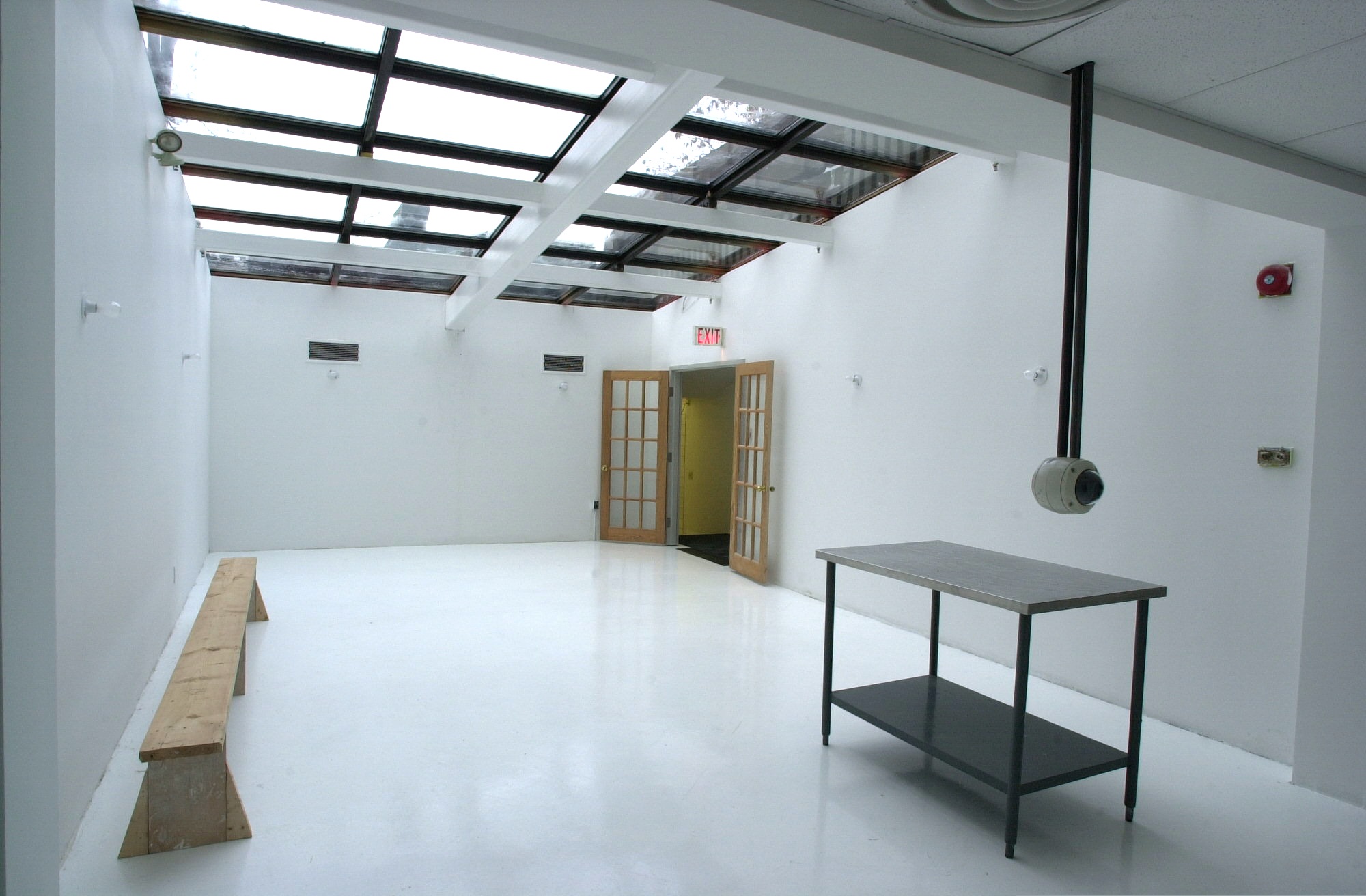
CAPTION FOR FIGURE 2: Decontrabanding gallery showing wooden bench,
stainless steel table, and body scanner, all under a glass ceiling
(windows in the ceiling provide natural light and ``transparency'').
In this gallery there is a wooden bench that is exactly 12 feet long, upon which the 12 men are asked to seat themselves. There is a stainless steel surgical table in front of the bench. Initially a decon officer asks each person to empty his pockets onto the table to make sure that there is no obvious contraband (guns, knives, nail clippers, box cutters, etc.). Next the men are asked to remove all clothing, jewellery, and personal effects. They are each instructed to place these items into the clear plastic contrabag with their shoes. Contrabags are checked in at the bagging counter, where a bagging officer seals the bags with a tie wrap gun with a serial-numbered evidence tag.
The bagging counter is illustrated in FIGURE 3.
FIGURE 3:
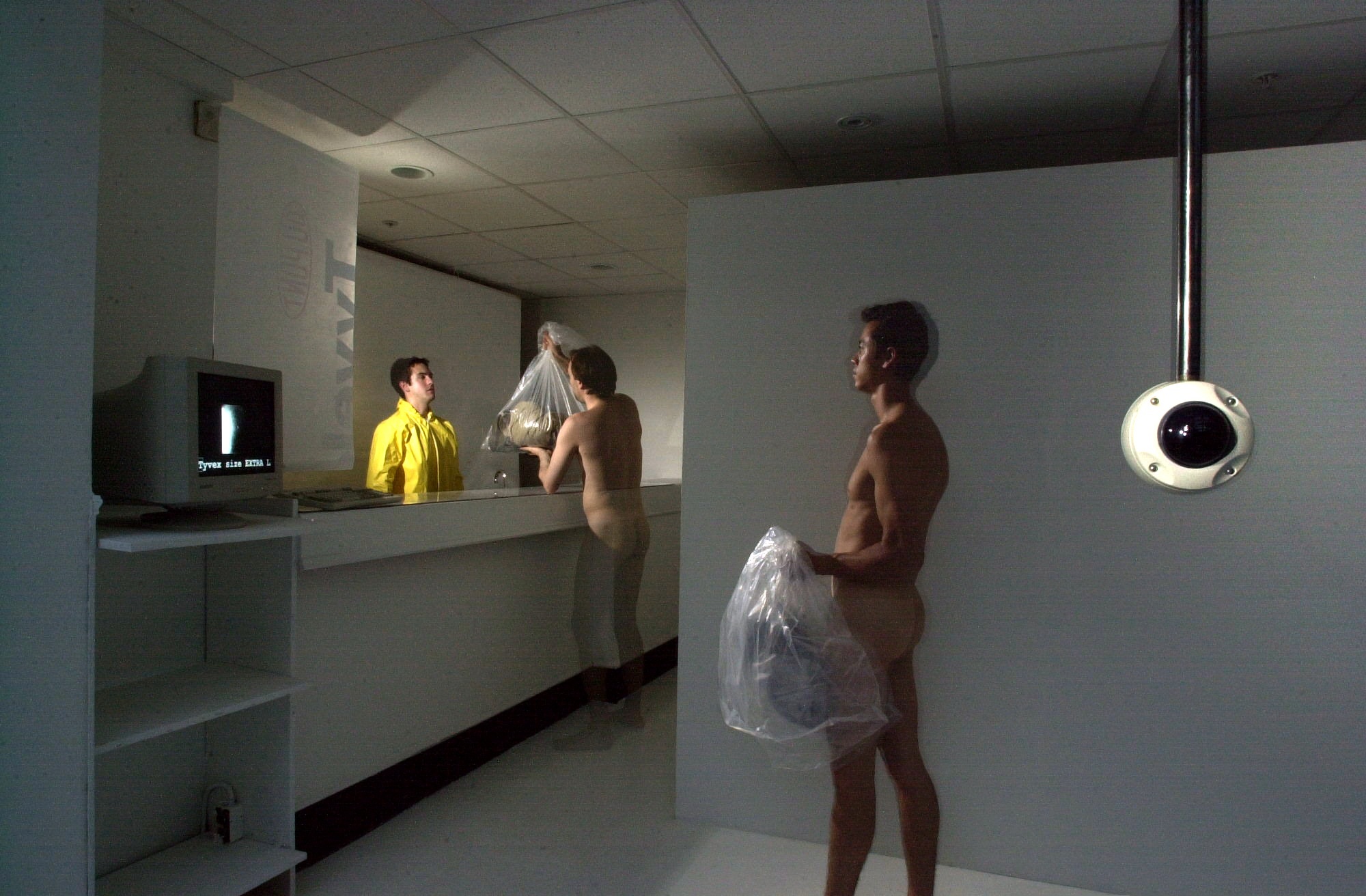
CAPTION FOR FIGURE 3: Bagging counter and clothing check-in.
Notice also the body scanner rightmost in the picture. This will be
explained later, and is used after the suspects return from decontamination.
FIGURE 4:
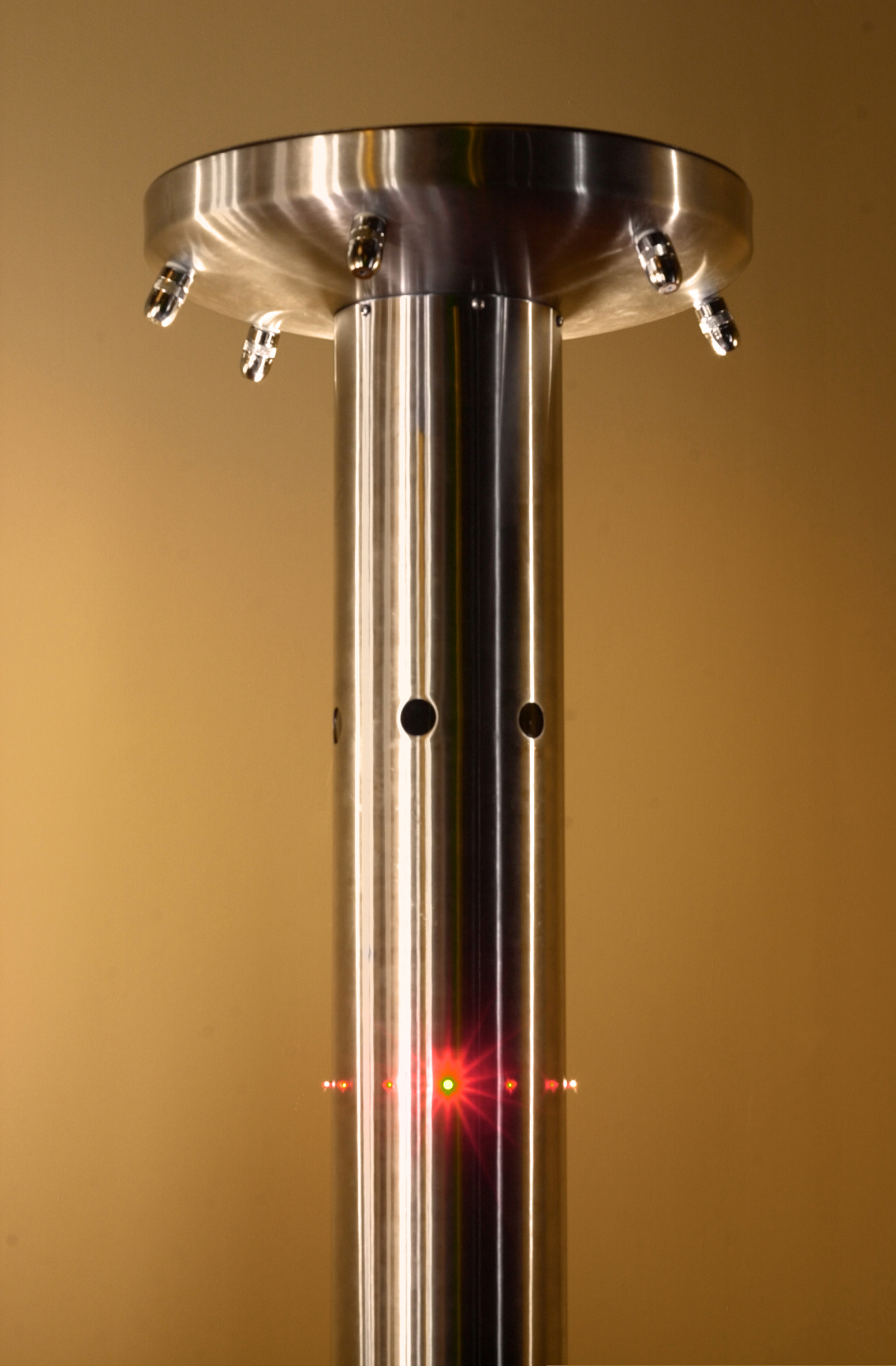
CAPTION FOR FIGURE 4: ``Panopdecon''
Panoptic shower as interactive video installation
using six built-in video cameras with computer
vision system for body tracking to create an
interactive shower spray that follows the users.
The cameras are connected to six video capture cards in a six-slot rack mounted computer vision system, running our custom hexagraphic algorithms.
The shower is in a clean white room, having three design elements: a partially silvered mirror/window; a water control system; and the shower itself. See FIGURE 5.
FIGURE 5:
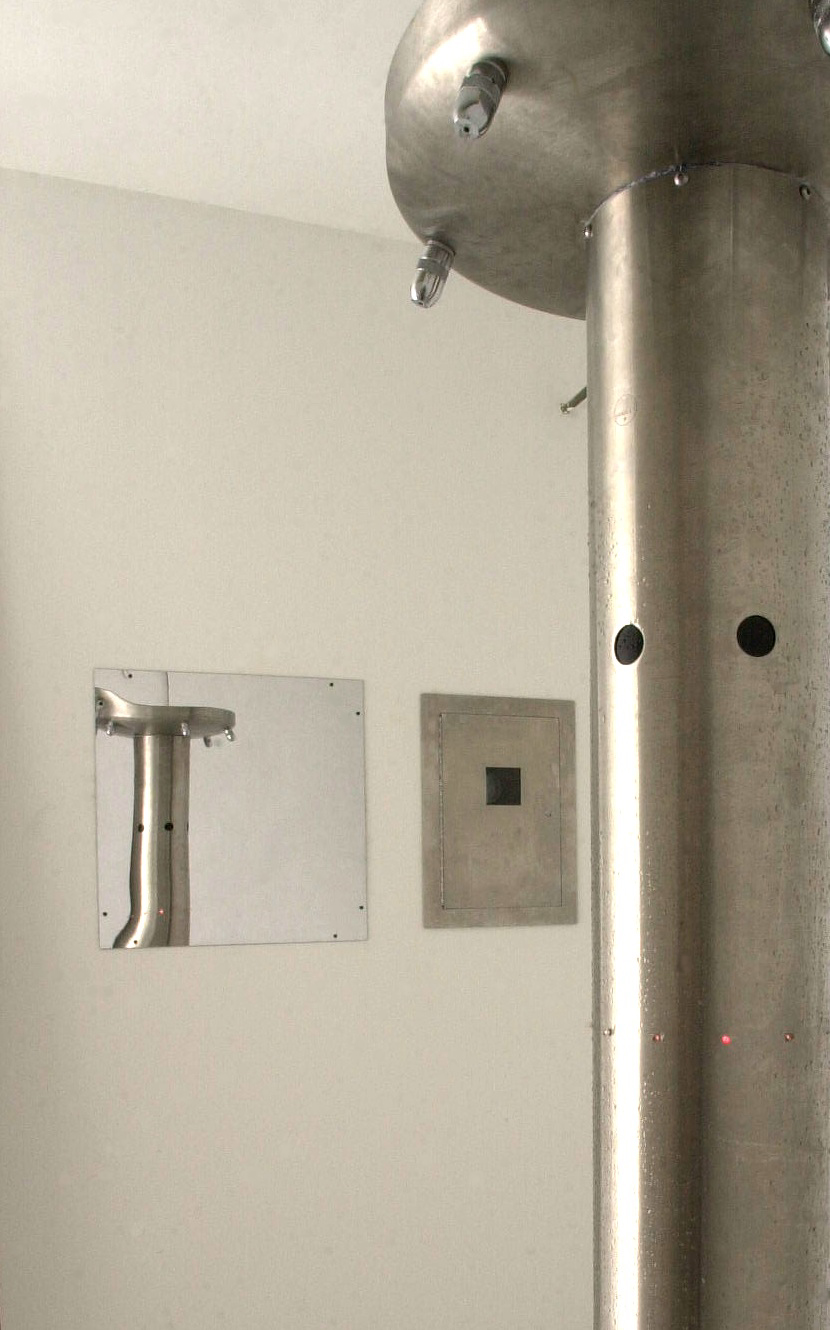
CAPTION FOR FIGURE 5:
Three design elements (appearing left-to-right):
FIGURE 6:
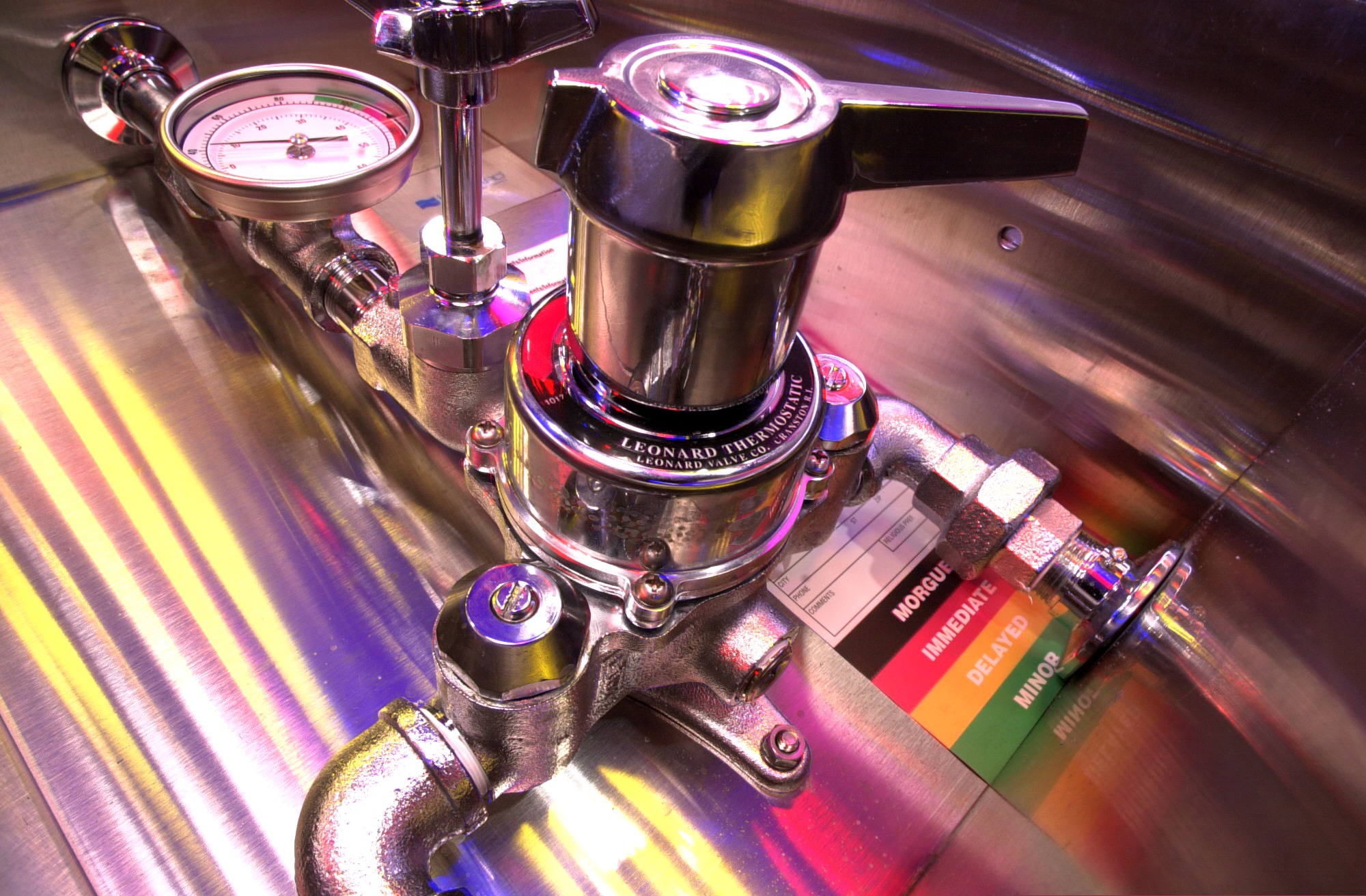
CAPTION FOR FIGURE 6: Closeup detail of the water control system.
Behind the mirror is the (de)control room where the plumbing, process controls, and computer vision system reside. A computer vision system uses simple image statistics to compute where bathers are located, and thus direct water flow (under computer program control) at the bathers. Additionally, for safety and security, a shower operator is stationed in the (de)control room to manually override the system, if necessary. FIGURE 7 shows a screen grab from the decontrol room operator's computer console that displays the automated computer vision algorithm progress.
FIGURE 7:
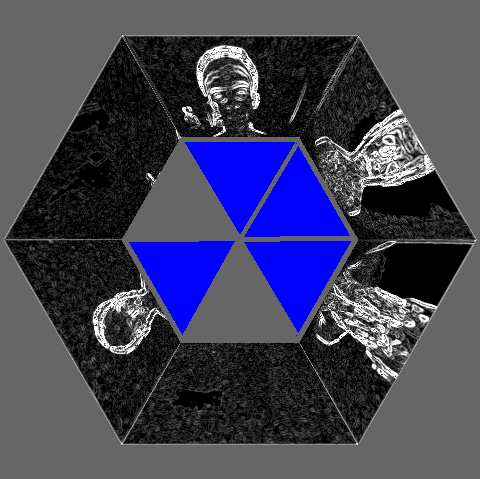
CAPTION FOR FIGURE 7: Screen grab from decontrol room. Blue regions
indicate water flow in sectors where the computer vision system has
detected a properly positioned bather. Here four bathers have been
detected.
Manual override may be done with a hexagonal-shaped (de)control panel, as shown in FIGURE 8.
FIGURE 8:
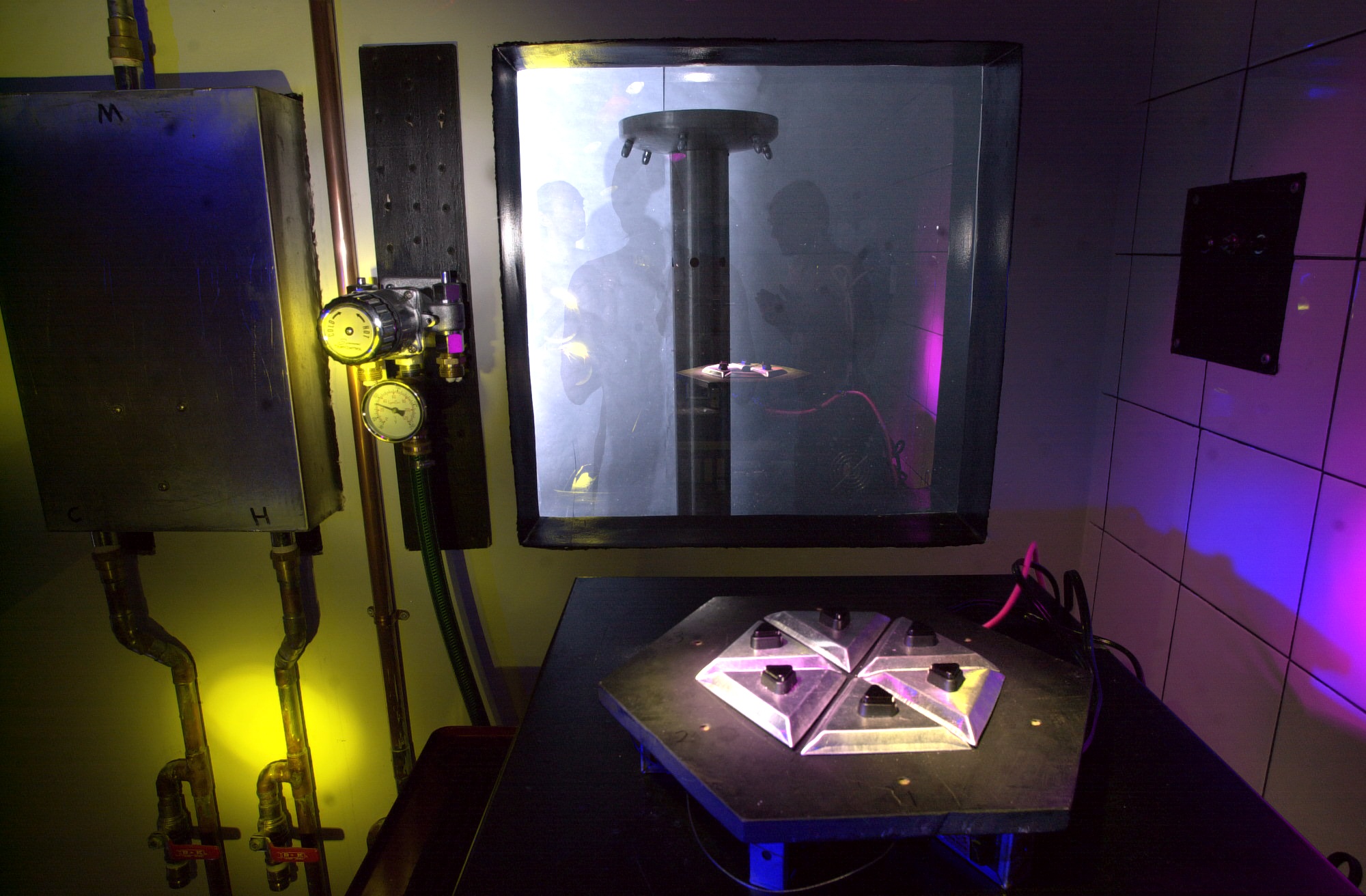
CAPTION FOR FIGURE 8: Decontrol panel comprising six triangular metal
plates with a triangle-shaped pushbutton switch on each one. The six
triangles make up the hexagonal shape of the panel. The panel is
oriented and wired so that there is a one-to-one correspondence with
the six nozzles as viewed through the mirror/window.
Because the decontrol room is dark, the mirror/window functions as a mirror when viewed from the shower room, and as a window when viewed from the decontrol room side. In order to protect the privacy of the decontaminees, the Chief Privacy Officer (CPO) ensures that the operator is a person of the same gender as those undergoing decontamination.
As the first six men are undergoing decontamination, the next six men are directed into the shower room. After the two sets of six men have been decontaminated, all 12 of them line up along the wall opposite the bench.
They are directed one-by-one to stand in front of the body scanner.
The body scanner is shown in FIGURE 9.
FIGURE 9:
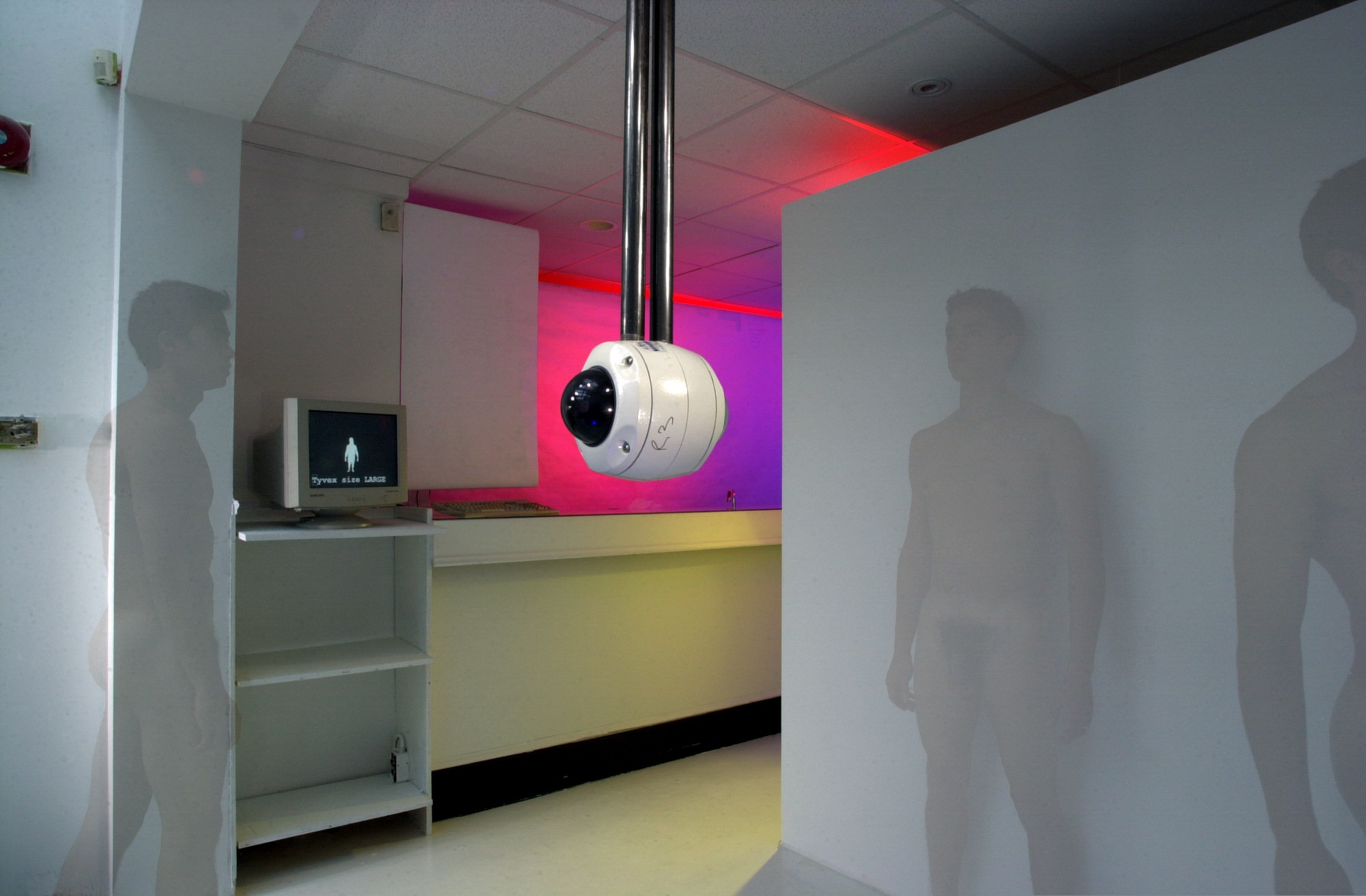
CAPTION FOR FIGURE 9: Full-body scanner for scanning suspects
immediately after they return from the showers.
The body scanner comprises an infrared sensor array connected to a DEC Alpha supercomputer. It calculates body dimensions, and computes the optimal design for a uniform. This information can then be used to either custom-tailor a uniform, or to select from a fixed stock of pre-made uniforms. In this exhibit, the uniforms are all pre-made, of white Tyvek (TM). The limited selection of sizes available corresponded, perhaps, to the common approach of decon officials with regard to decontaminating society - of toxic substances, toxic individuals or toxic ideas.
FIGURE 10 shows a screen capture from the body scanner.
FIGURE 10:
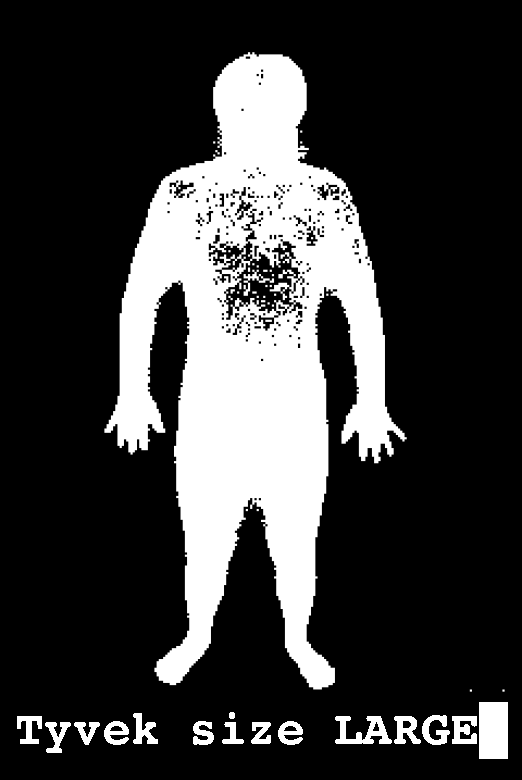
CAPTION FOR FIGURE 10: Screen capture from body scanner.
The process is very streamlined and works quickly, so that thousands of people could, in principle, be processed in such a facility, in a short period of time. Figure 11 illustrates the streamlining process.
FIGURE 11:
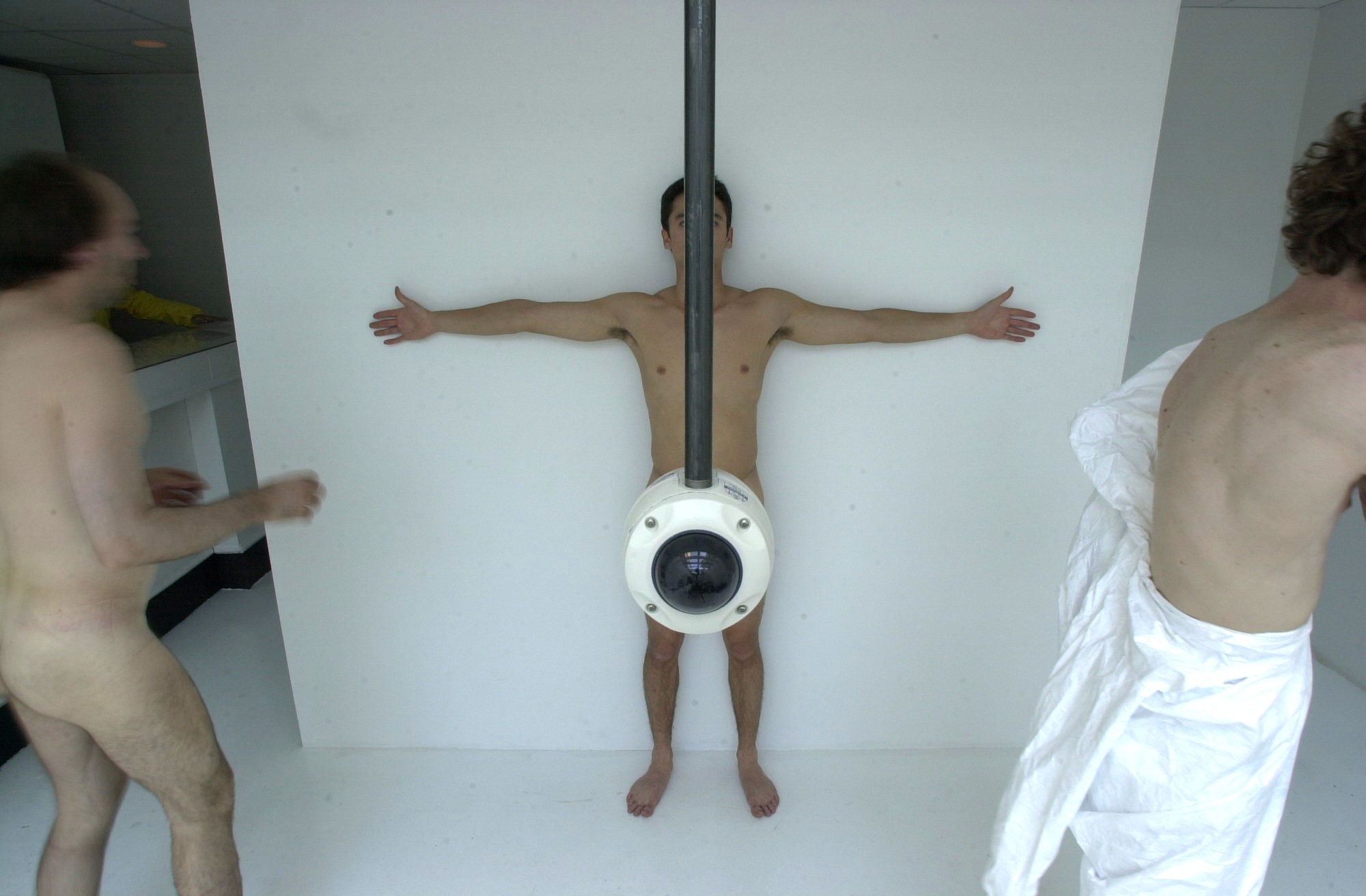
CAPTION FOR FIGURE 11:
People lined up at the left proceed to be scanned, and are quickly
handed a Tyvek (TM) jumpsuit in their size, and then put it on and line up
at the right. The white jumpsuits have no pockets in which to conceal
contraband.
The body scanner is mounted from the suspended ceiling by way of steel tubing, and all the wiring runs inside the steel tubing to give it a nice clean look, as shown in FIGURE 12.
FIGURE 12:
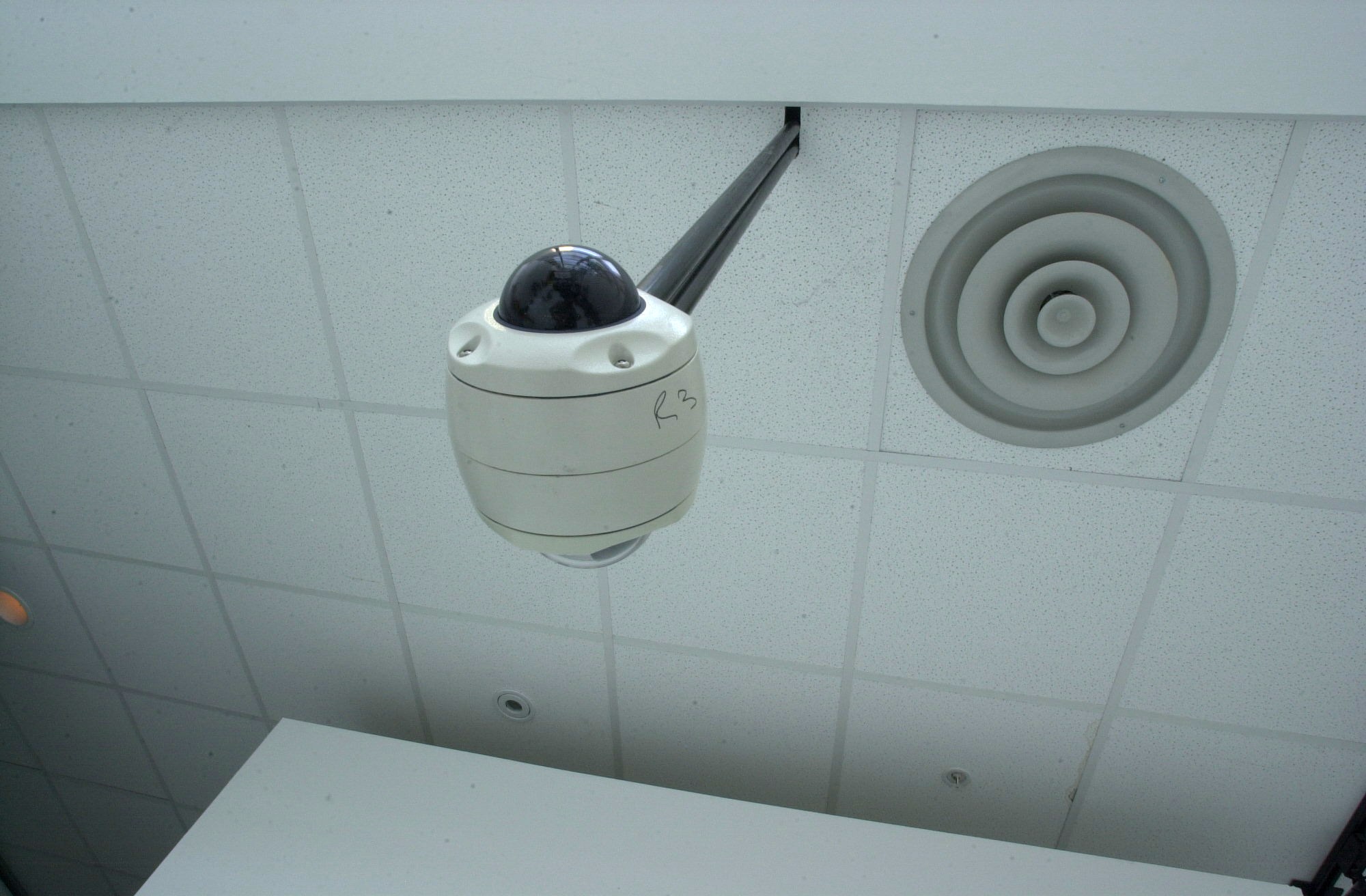
CAPTION FOR FIGURE 12: Closeup view of full-body scanner.
After the 12 men are processed, and clad in the white jumpsuits, they are led upstairs to the upper room, and out onto the roof.
When all of the men are clear from the decontrabanding gallery and decontamination gallery, there is a staff change, wherein the male decon officers are replaced with female decon officers, and then 12 women are admitted into the decontrabanding gallery. The process alternates, roughly 15 minutes for men, 15 minutes for women, and so on, until all of the attendees have processed through decon.
At this point there is a rooftop address: the keynote address (Mann) followed by an address by CAE's Steve Kurtz.
Then a wine and cheese reception took place one floor down, as the official opening of the exhibit, with informal discussion, etc..
Reduction in corporeal discrimination allowed us to draw together as a society, and through the World Wide Web, we connected into what was beginning to be a collective consciousness. With the advent of the ``new wave androgyny'' many establishments no longer had separate washrooms for men and women. For example, in many North American night clubs, dance clubs, etc., men and women shared a single communal washroom. At this time it also became fashionable, in some circles, to be androgynous, and thus blur the the gender boundary that had formerly been a hard and discriminatory boundary.
At around this time, university dormitories began to have communal showers that were no longer separated by gender. For example, MIT's East Campus dormitory has co-ed showers and commodes. The end of the segregation of gender had thus hit mainstream academia, and even the MIT pub had a single communal washroom for both genders.
Some European countries are also tending toward lesser corporeal emphasis. For example, the main conference hotel in Stuttgart Germany has a communal locker room in their hotel fitness center. Men and women shower naked together in a large open room with shower nozzles around the outside. Likewise in many of the surrounding bathing establishments such as Schwaben Quellen, Das Leutz, Isle der Ruhe, etc., whereas one of the few remaining bathing establishments with separate areas for men and women (Berg) is an historical site, maintaining its more than 100 year old tradition.
Thus it appeared that the old days of having men and women stand in separate lines had come to an end, at least among the segments of the population more focused on the mind than the body.
But something changed all that, and suddenly, in the age of terror, the body came back into focus. With the recent rise in global terrorism we now see racial profiling --- a return to racial discrimination. Thus the kind of body that a person has suddenly matters. When the table salt spills at a restaurant, and the National Guard is called in to deal with a ``mysterious white powder'', patrons are detained, separated by gender, and stripped for decontamination showers. Like cattle, detainees and disease suspects are separated by gender, by race, or by other corporeal categories, and then processed in a mechanized fashion.
To quote a recent article, ``It's like putting humans through a car wash after first destroying their garments.'' (http://wearcam.org/decon/)
DECONference raised many important questions regarding this transition from the postcorporeal (cyborg) era to the postpostcorporeal (postcyborg) era. However, a number of relevant questions remained: Are we seeing a return to significance placed on the body, or is the body merely seen as a crude marker for what might exist in the mind? Has the body truly fallen into obsolescence with regard to its ability to influence society, marked by its ubiquity throughout the culture and its shift from utilitarian consideration into something more akin to art? To be sure, there is a relatively recent increase in the prevalence and popularity of ``body art'' such as scarification, tattooing, and body piercing, and cosmetic surgery. Gratuitous use of the body has become ubiquitous throughout our popular culture. According to Marshall McLuhan, ubiquity and the shift to art (or recreation) are key indicators of a medium's obsolescence. Thus, in the cyborg (postmodern) era, it seemed as though the body was obsolete.
But now, the notion of the body as obsolete (art), is itself obsolete, as we witness a renewed emphasis on physical characteristics as markers of intention, such as when those in charge of security select those with darker complexions for closer scrutiny. Such renewed emphasis on the body may suggest that the mind is the new medium to eventually be made obsolete. This takes us to the postcyborg age where the ``mind is obsolete''.
This notion of the mind-as-art is how we, as a culture, are restructuring the mind through various technologies and modifications.
Unlike previous work in inverse surveillance, known as ``sousveillance'' (a direct inverse panopticon), DECONcert explored the notion of community, interaction, and connectedness among participants.
DECONversation engaged the author, Steve Mann and Stelarc, in a lively conversation to explore the technological extensions of the body. Stelarc argues that the body is obsolete, and that we exist in a post-corporeal age in which our cybernetic extensions define a new sort of physical existence: "The body has been augmented, invaded, and now becomes a host, not only for technology, but also for remote agents. As the internet provides extensive, interactive ways of displaying, linking and retrieving the body information and images, it may now allow unexpected ways of accessing, interfacing and uploading the body itself''.
Stelarc's notions of being ``augmented, invaded'' and becoming a host for ``remote agents'' are informed by various of his performance pieces, including Exoskeleton, Stimbod, Fractal Flesh, ParaSite, among many others.
The author (Mann) on the other hand, makes explicit our more real and immediate experience of being cyborgs, through the use of technological extensions of the cellular phone, internet connections, personal digital assistants, ubiquitous video and digital cameras, and, in true McLuhan fashion, our clothing.
The author, himself an explicit cyborg for over thirty years, was unfortunately and unwillingly ``de-cyborged'' during an interaction with Air Canada [Paul Virilio, ``Crepuscular Dawn'', New York: Semiotext(e). paperback, 164pp. ISBN: 1-58435-013-X, pages 96 to 99]. While perhaps being the first to ``bump into'' the post-cyborg forces around us, the author is not the only one who will likely be affected by these forces. These are forces that will effect all of us profoundly, for in the era of terror, anything can happen, in a direction beyond the postmodern.
The modern panopticon is served well by Stelarc's vision. With our bodies technologically extended and connected to a ubiquitous network, able to be invaded and remotely accessed, surveillance cameras that now pervade our public spaces will become a cumbersome and redundant artifact. Rather, one can easily imagine a society in which we are all uniquely addressable and locatable via current technologies. Given the current psycho-technological climate in the United States, for instance, the total surveillance scenario is not at all far-fetched:
The Total Information Awareness database proposed by the Defense Advanced Research Projects Agency, combined with the USA PATRIOT Act, and its sequel, the Domestic Security Enhancement Act of 2003, will be able to construct a composite profile of almost anyone based on behaviours inferred by computationally recorded activities. The missing link, to physically locate and track suspected individuals, may easily be addressed by the numerous technological extensions to our body that we willingly and eagerly embrace. Thus, the obsolescence of the body, and its replacement by our cyborg outgrowth could encroach on our personhood and personal freedom in favour of alleged or false promises of safety and security.
The author's life-long skepticism of the benign nature of these authoritarian paternalism hopefully calls into question the alleged tradeoff between safety and security: That which makes us safe does not necessarily make us free, or even secure.
The mediated reality of cyberspace, where our acts and thoughts can be watched not only by one guard but by many different guards, creates simultaneous feedback for our own awareness of the control we have over our own body.
The prisoners in Benthem's panopticon were aware that they were being watched by the guards, although each prisoner remained isolated from all the other prisoners. The modern panopticon of cyberspace is a reversal of Bentham's original. The guards are hidden from our view and our consciousness, although we are not only aware of the other prisoners, we are encouraged to connect to them. However, in doing so, we may unwittingly be inviting the panopticon's unblinking technological gaze by becoming constrained cyborgs.
However, cyborg extensions are neither exclusively, nor inevitably, detrimental to our existential freedom. One criticism and common complaint about the (post)modern condition is its isolation. By extending ourselves via internet connections and other means of instantaneous communications, our computational beings may connect, but we may lose a humanistic element. Is there a way to use technological extensions to connect humanistically to one another? This is an important goal of Connected Collective Humanistic Intelligence (CCHI, or ``Hintelligence'', for short [Steve Mann, ``Intelligent Image Processing'', John Wiley and Sons, 2001]).
Further, in using cyborg technology to explicitly connect mind to mind, there is the possibility of a restructuring of the mind that occurs that we might consider beneficial to our evolution as a culture. These were the goals of the exploration undertaken during the Cyborg Echoes DECONcert (http://wearcam.org/deconcert/index.htm ``Music in the Key of EEG'').
DECONcert used electroencephalogram (EEG) sensors which sensed electrical activity produced in the brains of participants. 48 participants were equipped with EEG sensors, and the signals from the brains of the participants were used as signals to modify (e.g. modulate, etc.), and in some ways generate, a computationally controlled soundspace. DECONcert allowed participants to form a computational feedback loop with the process of musical composition, using an implementation of Humanistic Intelligence.
This formed a collective feedback loop where output from the group of participants is sensed by the computer. The computer then generates music based upon this response, which the participants experience. That experience of course changes their brainwave patterns, so that the participants collectively affect the computer and the computer affects the participants. Thus a collective stream-of-deconsciousness arises, much like a dreamlike meditative state of multi-threaded thought that is neither conscious, subconscious, or unconscious.
Thus we have an implementation of Intelligent Signal Processing to continually re-generate the music as part of this feedback loop, with the kind of enhanced perceptual sensitivity characterized by early regenerative radio receivers.
Bentham's panopticon isolated the prisoners from each other, while keeping them visible to the guards. DECONcert, in contrast, allowed the participants to interact deconsciously with each other. DECONcert makes explicit the mind, and thus reverses the effect of the panopticon, as a cultural probe into both the mind and body.
The apparatus used in DECONcert required no prostheses, tools, devices, or personal belongings from the participants. Participants formed a collective atmosphere with only their thoughts and thus it was a collaborative system which could function even when participants were relieved of their shoes, clothing, jewellery, and personal belongings which could be considered potential "contraband."
Moreover, the interaction in DECONcert took place even with participants physically isolated from each other. The physiological signals generating this interaction can come from the minds of the participants in the manner of a Ouiki (http://wearcam.org/ouiki/index.htm) and thus be outside the visibility of the guard.
DECONcert was a tangible extension and of the previous night's DECONversation. Rather than using technological extensions to invade, surveil and isolate people from one another, DECONcert connected multiple minds as a single musical instrument, with physiological signals operating "in concert", i.e. together, to create a unique technosocial harmony.
Sound from DECONcert can be heard at http://www.mcluhan.utoronto.ca/deconcert_begin.mp3 and http://www.mcluhan.utoronto.ca/deconcert_end.mp3
The interaction of technology with mind resulted in a collective telematic prosthesis of the mind. Such mind modification transcends body modification and explicit cyborgism that merely extends the body. In DECONcert we explored the comparison of the robotic body and the cyborg minds.
FIGURE 13:

CAPTION FOR FIGURE 13: Telematic Tubs Against Terror ("Bapterrorism")
The idea of having people in different places bathing in the same wave state (same temperature water, same wave patterns, etc.) is accompanied with projections of shadows on the translucent outer surfaces of the tub. Additionally, there is provided a notion of "hysterical relaxation". The hot tub is traditionally a place to relax, but in the age of bioterror, is a place to be free of contamination, free of contraband, and free of the liberty to conceal. Moreover, the word "hysterical" derives of the womb, which is further suggested by the umbilical cord formed by the electrodes worn by each participant.
The author suggests clothing as the border of the sovereign nation, as well as an architecture of one (e.g. a building built for a single occupant). The interplay between cyborg, postcyborg, and postpostcyborg (deconism) is a war at the corporeal boundary defined by our clothing and other technological prostheses. Yet we may also explore the low-intensity peacefare inherent in the telematic interfaces that connect these borders. The archiotic (architectural semiotics) elements of clothing allow us to redefine the naked cyborg of the postcyborg era.
Wood, D., 'Technology, Territory and Transgression: Algorithmic Surveillance in Public Spaces and the Displacement of Politics'. Given at: Transforming Spaces: The Topological Turn in Technology Studies, Techncial University of Darmstadt, Germany, 22-24 March, 2002. Freud, S.[IJP 13:405; Psychoanal. Q. 1:210] (1932). The acquisition and control of fire., SE, 22:187-193. Freud, S. [SE 22:187] (1932). The acquisition of fire., Psychoanal. Q., 1:21 0-215. Freud, S. [SE 22:187] (1932). The acquisition of power over fire., Int. J. Psychoanal., 13:405-410. McLuhan, Marshall, and Eric McLuhan, Laws of Media - The New Science. Toronto: University of Toronto Press, 1988. Mann, Steve, and Hal Niedzviecki, Cyborg: Digital Destiny and Human Possibility in the Age of the Wearable Computer. Toronto: Doubleday Canada, 2001.